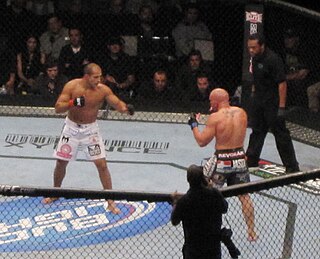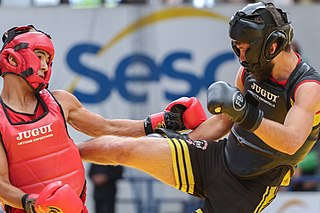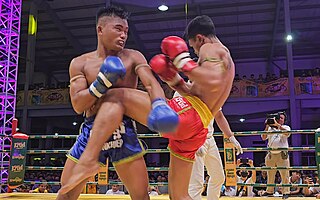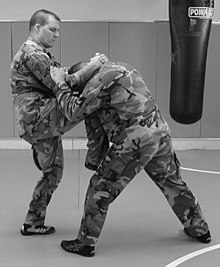
Kickboxing is a full-contact hybrid martial art and boxing type based on punching and kicking. Kickboxing originated in the 1950s to 1970s. The fight takes place in a boxing ring, normally with boxing gloves, mouth guards, shorts, and bare feet to favor the use of kicks. Kickboxing is practiced for self-defense, general fitness, or for competition. Some styles of kickboxing include: Full contact karate, Muay Thai, Japanese kickboxing, Lethwei, Sanda, and Savate.

A kick is a physical strike using the leg, in unison usually with an area of the knee or lower using the foot, heel, tibia (shin), ball of the foot, blade of the foot, toes or knee. This type of attack is used frequently by hooved animals as well as humans in the context of stand-up fighting. Kicks play a significant role in many forms of martial arts, such as capoeira, kalaripayattu, karate, kickboxing, kung fu, wing chun, MMA, Muay Thai, pankration, pradal serey, savate, sikaran, silat, taekwondo, vovinam, and Yaw-Yan. Kicks are a universal act of aggression among humans.

Muay Thai, sometimes referred to as Thai boxing, is a Thai martial art and full-contact combat sport that uses stand-up striking, sweeps, and various clinching techniques. This discipline is known as the "Art of eight limbs", as it is characterised by the combined use of fists, elbows, knees and shins. Muay Thai became widespread internationally in the late 20th to 21st century, when Westernised practitioners from Thailand began competing in kickboxing and mixed-rules matches as well as matches under Muay Thai rules around the world. The professional league is governed by The Professional Boxing Association of Thailand (P.A.T.), sanctioned by The Sports Authority of Thailand (S.A.T.).

Mixed martial arts (MMA) is a full-contact combat sport based on striking, grappling and ground fighting, incorporating techniques from various combat sports from around the world. The first documented use of the term mixed martial arts was in a review of UFC 1 by television critic Howard Rosenberg in 1993.

A strike is a directed, forceful physical attack with either a part of the human body or with a handheld object, intended to cause blunt or penetrating trauma upon an opponent.

Sanda, formerly Sanshou, is the official Chinese boxing full-contact combat sport. Sanda is a fighting system which was originally developed by the Chinese military based upon the study and practices of traditional Chinese martial arts and modern combat fighting techniques; it combines boxing and full-contact kickboxing, which includes close range and rapid successive punches and kicks, with wrestling, takedowns, throws, sweeps, kick catches, and in some competitions, even elbow and knee strikes.

Kun Khmer or Pradal Serey is a combat sport that originated in Cambodia. The sport consists of stand up striking and clinch fighting where the objective is to knock an opponent out, force a technical knockout, or win a match by points. The sport was codified in Cambodia by the French colonial administration in the early 20th century and derives from centuries-old traditions, namely Bokator, the close-quarter combat system used during the Khmer empire. The official Khmer name of the sport is Kbach Kun Pradal Khmer.

Lethwei or Burmese boxing is a full contact combat sport from Myanmar that uses stand-up striking including headbutts. Lethwei is considered to be one of the most brutal martial arts in the world, as the sport is practiced bareknuckle with only tape and gauze while fighters are allowed to strike with their fists, elbows, knees, and feet, and the use of headbutts is also permitted. Disallowed in most combat sports, headbutts are important weapons in a Lethwei fighter's arsenal, giving Lethwei its name of the "Art of nine limbs". This, combined with its bareknuckle nature, gave Lethwei a reputation for being one of the bloodiest and most violent martial arts. Although popular throughout modern Myanmar, Lethwei has been primarily and historically associated with the Karen people of the Kayin State; vast majority of competitive Lethwei fighters are ethnolinguistically of Karen descent.

Duane Paul Ludwig is an American mixed martial arts coach, retired professional kickboxer and mixed martial artist.
Jeffrey Ryan "Duke" Roufus is an American former kickboxer and head coach of the Roufusport based in Milwaukee, Wisconsin, United States. He is a well-known striking coach in North America.
The International Kickboxing Federation (IKF) is a sanctioning body for kickboxing and Muay Thai based in the United States. The IKF sanctions and regulates all aspects of these sports from Semi Contact to Full Contact in both Amateur and professional levels. The IKF World Headquarters located in Newcastle, California, USA oversees over 2,000 IKF events a year around the world.

A roundhouse kick is a kick in which the practitioner lifts the knee while turning the supporting foot and body in a semicircular motion, extending the leg striking with the lower part of the shin and/or the instep. The ball of the foot can also be used to strike the target and is preferable when power breaking thick boards. This type of kick is utilized in many different martial arts and is popular in both non-contact and full-contact martial arts competitions. The kick has many variations based on stance, leg movement, striking surface, and the height of the kick.

In martial arts and combat sports, stand-up fighting is hand-to-hand combat between opponents in a standing position, as distinguished from ground fighting. Clinch fighting is stand-up grappling. Fighters employ striking, including striking combinations, using either body parts or mêlée weapons, to incapacitate or injure the opponent. Combatants use blocking techniques to block the opponent's attacks.

An elbow strike is a strike with the point of the elbow, the part of the forearm nearest to the elbow, or the part of the upper arm nearest to the elbow. Elbows can be thrown sideways similarly to a hook, upwards similarly to an uppercut, downwards with the point of the elbow, diagonally or in direct movement and in several other ways, like during a jump. Elbow strikes are native to traditional Southeast Asian martial arts, traditional Chinese martial arts and traditional Okinawan martial arts.

Clinch fighting or trapping is the part of stand-up fighting where the combatants are grappling in a clinch, typically using clinch holds. Clinching the opponent can be used to eliminate the opponent's effective usage of some kicks, punches, and melee weapons. The clinch can also be used as a medium to switch from stand-up fighting to ground fighting by using takedowns, throws or sweeps.
Marvin Lee Eastman is a retired American professional mixed martial artist and kickboxer. A professional MMA competitor from 2000 until 2013, he competed in K-1, the Ultimate Fighting Championship (UFC), World Fighting Alliance (WFA), Maximum Fighting Championship (MFC), Shooto, and King of the Cage (KOTC), where he was Super Heavyweight Champion.

Amir Ali Sadollah is a retired American mixed martial artist, formerly with the Ultimate Fighting Championship. He was the winner of Spike TV's The Ultimate Fighter 7. He has fought exclusively within the confines of the UFC Octagon since the beginning of his MMA career, making him one of the few fighters who have done so.
Kevin Rosier was an American kickboxer, boxer and mixed martial artist. He had much success as a kickboxer, winning a number of titles, but did not transition particularly well into the world of boxing and was mostly seen as a journeyman fighter. Notably, he also took part at the inaugural Ultimate Fighting Championship event in 1993 where he reached the semi-finals.

One Championship is a multinational combat sports promotion founded on 14 July 2011 by Chatri Sityodtong and Victor Cui. Originally focused on mixed martial arts (MMA), ONE has since expanded to regularly hold events featuring Muay Thai, kickboxing, and submission grappling bouts, while also previously promoting boxing and Lethwei matches. One held its first event on 3 September 2011 at the Singapore Indoor Stadium, and has since held over 200 events across Asia.

Joseph Francis Schilling is an American professional Muay Thai kickboxer and mixed martial artist who most recently competed for Bellator Kickboxing in the Middleweight division, and in the Middleweight division for Bellator MMA. He was released from Bellator in October 2020 after the Mohegan Tribe Department of Athletic Regulations refused to grant him a license to fight.

















